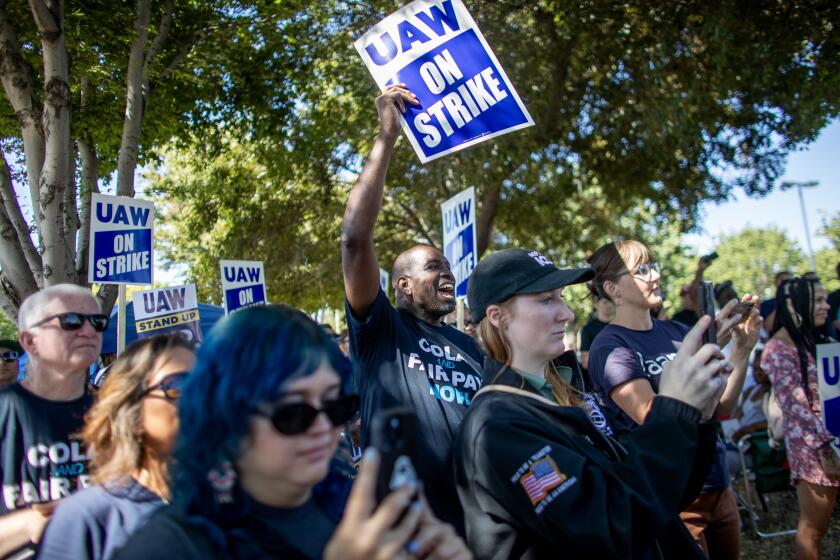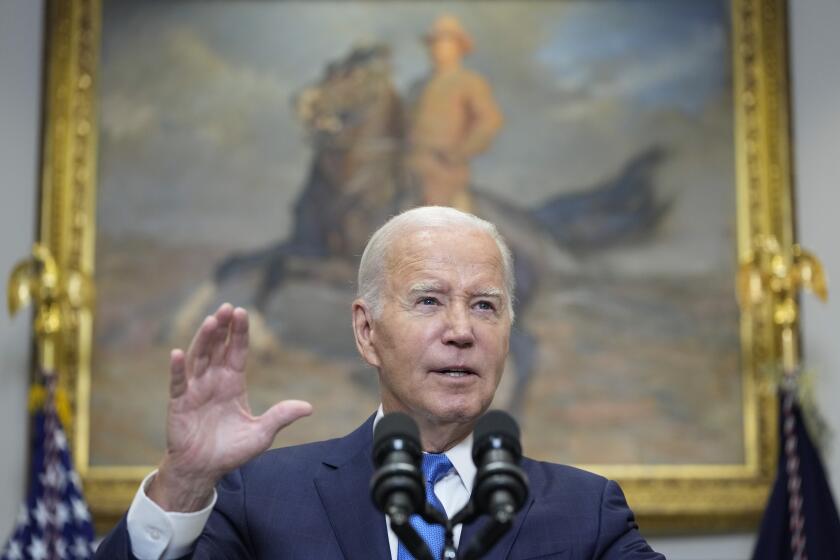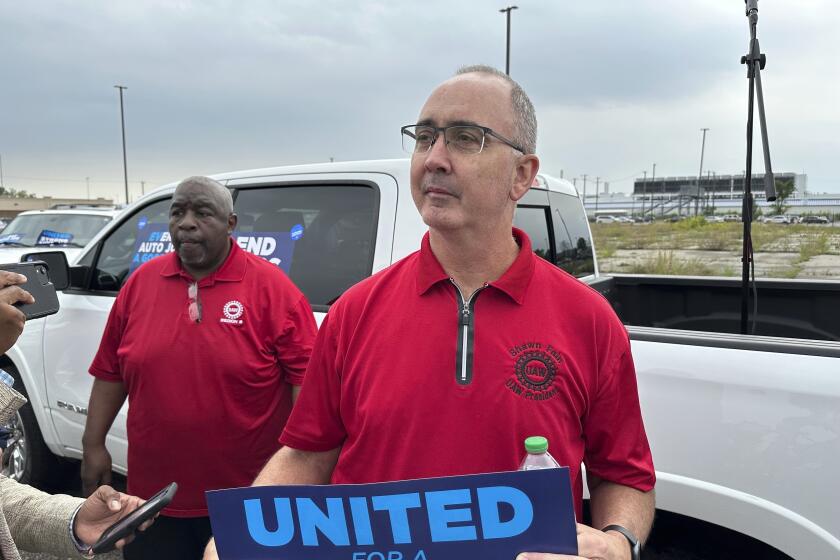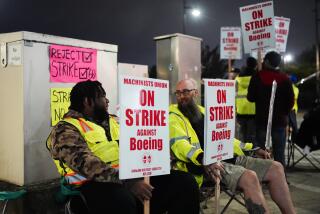Autoworkers say strike will spread to 7,000 more workers in Chicago, Lansing
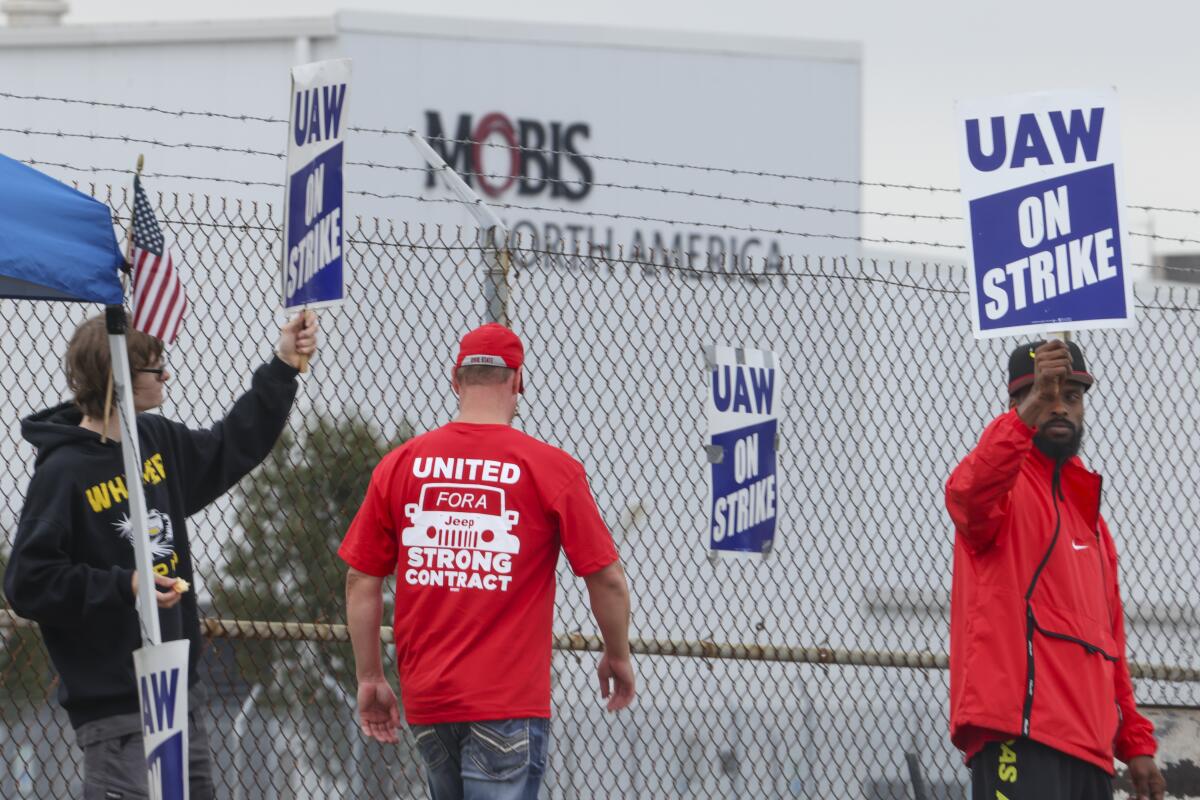
- Share via
The United Auto Workers union says its two-week strike against Detroit automakers will spread to 7,000 more workers at a Ford plant in Chicago and a General Motors assembly factory near Lansing, Mich.
Union President Shawn Fain told workers on a video appearance Friday that negotiations haven’t broken down but that Ford and GM have refused to make meaningful progress. Jeep maker Stellantis was spared from the third round of strikes.
The GM plant in Delta Township, near Lansing, makes large crossover SUVs such as the Chevrolet Traverse and Buick Enclave. A nearby metal parts stamping plant will remain open, Fain said.
The Chicago Ford plant makes the Ford Explorer and Explorer police interceptors, as well as the Lincoln Aviator SUV. The Explorer interceptor is the nation’s top selling police vehicle.
“Sadly, despite our willingness to bargain, Ford and GM have refused to make meaningful progress at the table,” Fain said in explaining the two new strike locations.
Inland Empire workers strike at GM and Stellantis parts distribution centers, in a widening labor action that could affect consumers’ ability to get car repairs.
Fain said union bargainers are still talking to all three companies. “I’m still very hopeful that we can reach a deal that reflects the incredible sacrifices and contributions that our members have made over the last decade,” he said.
Stellantis, he said, made significant progress “moments” before the Facebook Live broadcast by agreeing to unspecified cost-of-living pay raises, the right not to cross a picket line and the right to strike over plant closures.
“We are excited about this momentum at Stellantis and hope it continues,” Fain said. “Our strategy is working.”
But General Motors was less optimistic, with manufacturing head Gerald Johnson accusing the union of calling more strikes “just for the headlines, not real progress.”
In a note to workers, Johnson said the company has not yet received a counter offer from union leaders to an economic proposal it made on Sept. 21.
The United Auto Workers strike has exposed tensions between President Biden’s goals of fighting climate change and supporting unions.
“We continue to stand ready and willing to negotiate in good faith to reach an agreement that benefits you and doesn’t let the non-union manufacturers win,” Johnson wrote, calling the counter offer a record proposal with historic wage increases and job security.
Ford scheduled a 1 p.m. briefing by CEO Jim Farley for industry analysts and reporters to discuss the talks.
Automakers have long said that they’re willing to give raises to workers, but fear that too rich of a contract will drive up the prices of their vehicles, making them higher than those made at nonunion U.S. plants run by foreign automakers, largely in the south. The union counters that labor costs are only 4% to 5% of the cost of a vehicle, and the companies are making billions in profits and can afford big raises.
Wedbush analyst Dan Ives wrote in a note to investors that the union’s expansion of strikes shows that both sides are digging in for what could be a could be a long battle.
Current offers on the table from the companies will add $3,000 to $5,000 to the cost of an average electric vehicle that would be passed on to consumers, Ives wrote. Such costs “would ultimately be a torpedo to the future business models” of the automakers, he wrote.
The union has vowed to hit automakers harder if it does not receive what it calls substantially improved contract offers as part of an unprecedented, simultaneous labor campaign against all three Detroit automakers.
Additional walkouts were to begin at noon Friday.
The automakers’ last known wage offers were around 20% over the life of a four-year contract, a little more than half of what the union has demanded. Other contract improvements, such as cost of living increases, restoration of defined benefit pensions for newly hired workers and an end to tiers of wages within the union are also on the table.
The union went on strike Sept. 15 when it couldn’t reach agreements on new contracts with the companies. Contracts expired at 11:59 p.m. Sept. 14.
The UAW initially targeted one assembly plant from each company. Last week it added 38 parts distribution centers run by GM and Stellantis. Ford was spared the second escalation because talks with the union were progressing at that time.
The union has structured its walkout in a way that has allowed the companies to keep making pickup trucks and large SUVs, their top-selling and most profitable vehicles. Previously it shut down assembly plants in Missouri, Ohio and Michigan that make midsize pickup trucks, commercial vans and midsize SUVs, all of which are profitable but don’t make as much money as the larger vehicles.
But the new strikes against GM and Ford target SUVs that are big moneymakers for both companies.
In the past the union had picked one company as a potential strike target and reached a contract agreement with that company that would serve as a pattern for the others.
But this year Fain introduced a novel strategy of targeting a limited number of facilities at all three automakers, while threatening to add more if the companies do not come up with better offers.
About 25,000 of the union’s 146,000 workers at the three automakers are on strike, allowing it to preserve a strike fund that was worth $825 million before Sept. 14.
As usual, the media and politicians are blaming the possibility of an auto strike on the auto workers union, but company managements are the guilty parties.
If all of the union’s auto workers went on strike, the fund would be depleted in less than three months, and that’s without factoring in health care costs.
More to Read
Inside the business of entertainment
The Wide Shot brings you news, analysis and insights on everything from streaming wars to production — and what it all means for the future.
You may occasionally receive promotional content from the Los Angeles Times.
